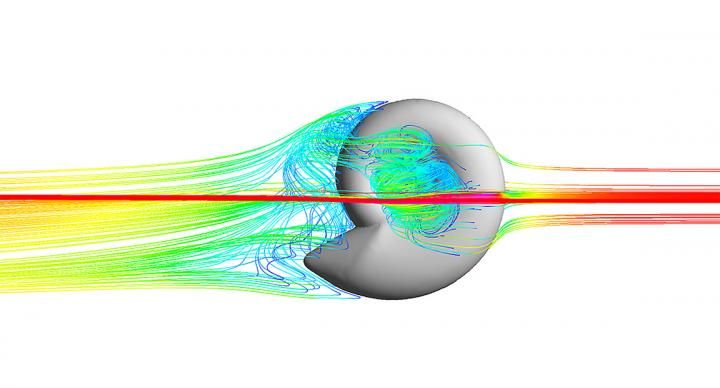Video Game-Inspired Models Demonstrate How Prehistoric Squid Relatives Swam Through the Seas
By simulating liquid flows around the shells of ammonoids, scientists study how these ancient animals moved
:focal(407x312:408x313)/https://tf-cmsv2-smithsonianmag-media.s3.amazonaws.com/filer/5e/d2/5ed24ad0-81bf-4998-880e-4ad9ca2d9bd2/asteroceras_bw.jpg)
Ammonoids are one of the world’s greatest evolutionary success stories. From about 66 to 409 million years ago, thousands of species of these shelled cephalopods thrived in seas all over the planet. The marine creatures were so numerous and evolved at such a rapid pace that paleontologists often use ammonoids as index fossils—specific species that mark particular swaths of prehistory, allowing scientists to date layers of rock by identifying the ammonoid fossils. But despite their past abundance, ammonoids and their behavior still remain something of a mystery to scientists.
Much like their extant nautilus cousins, ammonoids were soft-bodied cephalopods that lived inside coiled shells, which they grew throughout their lives. But squishy bodies often decay before fossilization, making the details of these creatures’ anatomy difficult to pin down. Learning simple behaviors of ammonoids, such as what a particular species ate, depends on delicate investigations of standout fossils, such as one ammonoid preserved with plankton in its mouth.
Much of what experts have learned about ammonoids is thanks to their hard shells which survive more readily in the fossil record. Now, techniques borrowed from engineering, physics and even video games are helping experts envision and examine these extinct animals in ways never before possible.
Paleontologists expect that all ammonoids squirted jets of water to propel themselves shell-first through the seas. In the past, University of Utah paleontologist Kathleen Ritterbush says, researchers would place physical ammonoid models in water tanks to get an idea of how the invertebrates moved. But new technology, presented this week at an American Physical Society meeting, has allowed scientists to take their ammonoid swimming experiments a step further.

The first step is making a digital recreation of the animals. “We make replicas of real fossils by using a laser scanner to produce a 3-D model,” Ritterbush says, which are then refined by PhD student Nick Hebdon. From there, the ammonoids are put through their paces.
“Our new results are all generated using computational fluid dynamics,” Ritterbush says. The process is nothing like the typical paleontological business of dusty fieldwork. The simulations were designed by Hebdon using an engineering tool called ANSYS FLUENT, and the 3-D ammonoid models were placed within virtual liquid flows.
“The result is gorgeous simulations and visualizations of how water would flow around, past, and eddy out beyond the shell,” Ritterbush says. Using such techniques, the researchers can investigate whether certain shell types are more susceptible to drag or if faster-flowing water changes how a particular shell performs.
“This research on ammonoid swimming is cutting edge science, not just for ammonoids but for animals in general,” says Royal Veterinary College biomechanics expert John Hutchinson.
What makes ammonoids especially suited to this research, Hutchinson notes, is that the size and shapes of their shells were the main determinants of how these cephalopods performed while swimming. Ammonoid shells are not as biomechanically complex as dinosaur or mammoth skeletons, which involve more uncertainty when modelling what the animals could or could not do. The ammonoid modeling, on the other hand, can resolve a much clearer picture of how the invertebrates moved. “It’s the closest that the scientists can get to doing experiments on the live animals,” Hutchinson says.
But even the relatively simple structures of ammonoids don’t fall into a one-shell-fits-all model. “Imagine the different physics of moving a shell the size of a garbanzo bean, or a golf ball, or a car tire, or a Fiat!” Ritterbush says. Shell size, current speed, how fast the shell was previously moving, and the ornamentation that makes ammonoids so recognizable all affect how they moved through the water. With new fluid dynamics tools, researchers can now study which shells were built for speed and which represent other modes of travel.
“We get surprises pretty much every time we run simulations and analyze the data,” Ritterbush says. For example, the fluid dynamics change based on whether an ammonoid had the flanks of its shell covered by new growth or had the old parts of the shell coil exposed. To compare various ammonoid sizes, the researchers measured their speeds in terms of the diameters of their own shells traveled per second.
“At small sizes and modest speeds, say a pizza-bagel jetting along at one diameter per second, it doesn’t really matter if the coil is smoothed over or exposed,” Ritterbush says. But among bigger ammonoid species, exposed central coils carry extra weight in the form of water trapped against the shell.
The simulations can also reveal details of hypothetical ammonoids that never existed, or have yet to be found. Early in the project, Ritterbush hired video game designer Olivia Jenkins to make an easy-to-navigate user interface to play with different ammonoid shapes. Not only can this tool refine existing models, but it allows the researchers to test speculative ammonoids unlike any known species.
“What if this same shell was more inflated? What if it lacked ribs, or had big clunky knobs?” Ritterbush wonders. By unlocking the dynamics of shell shapes, “we can show people how vibrant and weird the seas were in dinosaur time.” And by investigating how these biological whorls lived, perhaps experts can develop a better understanding of why ammonoids disappeared tens of millions of years ago.
/https://tf-cmsv2-smithsonianmag-media.s3.amazonaws.com/accounts/headshot/RileyBlack.png)
/https://tf-cmsv2-smithsonianmag-media.s3.amazonaws.com/accounts/headshot/RileyBlack.png)